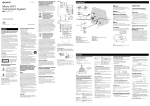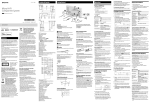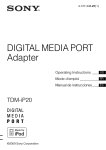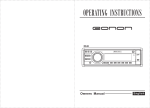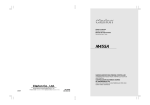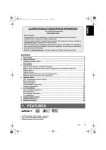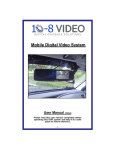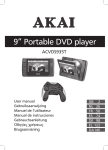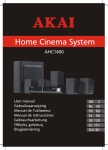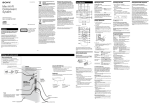Download Sony 4-183-777-12(1) Stereo System User Manual
Transcript
Disposal of Old Electrical & Electronic Equipment (Applicable in the European Union and other European countries with separate collection systems) This symbol on the product or on its packaging indicates that this product shall not be treated as household waste. Instead it shall be handed over to the applicable collection point for the recycling of electrical and electronic equipment. By ensuring this product is disposed of correctly, you will help prevent potential negative consequences for the environment and human health, which could otherwise be caused by inappropriate waste handling of this product. The recycling of materials will help to conserve natural resources. For more detailed information about recycling of this product, please contact your local Civic Office, your household waste disposal service or the shop where you purchased the product. Applicable accessories: Remote commander Disposal of waste batteries (applicable in the European Union and other European countries with separate collection systems) CAUTION WARNING The use of optical instruments with this product will increase eye hazard. To reduce the risk of fire, do not cover the ventilation opening of the apparatus with newspapers, tablecloths, curtains, etc. Do not place the naked flame sources such as lighted candles on the apparatus. To reduce the risk of fire or electric shock, do not expose this apparatus to dripping or splashing, and do not place objects filled with liquids, such as vases, on the apparatus. Do not install the appliance in a confined space, such as a bookcase or built-in cabinet. As the main plug is used to disconnect the unit from the mains, connect the unit to an easily accessible AC outlet. Should you notice an abnormality in the unit, disconnect the main plug from the AC outlet immediately. Do not expose batteries or apparatus with battery-installed to excessive heat such as sunshine, fire or the like. Excessive sound pressure from earphones and headphones can cause hearing loss. This appliance is classified as a CLASS 1 LASER product. This marking is located on the rear exterior. Notice for customers: the following information is only applicable to equipment sold in countries applying EU directives. The manufacturer of this product is Sony Corporation, 1-7-1 Konan Minato-ku, Tokyo, 108-0075 Japan. The Authorized Representative for EMC and product safety is Sony Deutschland GmbH, Hedelfinger Strasse 61, 70327 Stuttgart, Germany. For any service or guarantee matters, please refer to the addresses given in separate service or guarantee documents. This symbol on the battery or on the packaging indicates that the battery provided with this product shall not be treated as household waste. On certain batteries this symbol might be used in combination with a chemical symbol. The chemical symbols for mercury (Hg) or lead (Pb) are added if the battery contains more than 0.0005% mercury or 0.004% lead. By ensuring these batteries are disposed of correctly, you will help prevent potentially negative consequences for the environment and human health which could otherwise be caused by inappropriate waste handling of the battery. The recycling of the materials will help to conserve natural resources. In case of products that for safety, performance or data integrity reasons require a permanent connection with an incorporated battery, this battery should be replaced by qualified service staff only. To ensure that the battery will be treated properly, hand over the product at end-of-life to the applicable collection point for the recycling of electrical and electronic equipment. For all other batteries, please view the section on how to remove the battery from the product safely. Hand the battery over to the applicable collection point for the recycling of waste batteries. For more detailed information about recycling of this product or battery, please contact your local Civic Office, your household waste disposal service or the shop where you purchased the product. Note on DualDiscs A DualDisc is a two sided disc product which mates DVD recorded material on one side with digital audio material on the other side. However, since the audio material side does not conform to the Compact Disc (CD) standard, playback on this product is not guaranteed. Basic Operations Notes If your country or region does not support DAB broadcast, “No Service” appears. Do not press any button on the unit or the remote during DAB Automatic Scan. If scanning is interrupted, run the DAB Automatic Scan again. If you move to another area, repeat this procedure to store the stations for your new area. This procedure clears all previously stored presets. Before unplugging the DAB antenna, make sure the system is turned off to preserve your own DAB settings. This tuner does not support data services. Music discs encoded with copyright protection technologies This product is designed to playback discs that conform to the Compact Disc (CD) standard. Recently, various music discs encoded with copyright protection technologies are marketed by some record companies. Please be aware that among those discs, there are some that do not conform to the CD standard and may not be playable by this product. To use the iPod Insert an iPod Dock Adapter into the unit’s connector before use. License and Trademark Notice iPod is a trademark of Apple Inc., registered in the U.S. and other countries. “Made for iPod” means that an electronic accessory has been designed to connect specifically to iPod and has been certified by the developer to meet Apple performance standards. Apple is not responsible for the operation of this device or its compliance with safety and regulatory standards. MPEG Layer-3 audio coding technology and patents licensed from Fraunhofer IIS and Thomson. All other trademarks and registered trademarks are of their respective holders. In this manual, TM and ® marks are not specified. 2 Select the tuning mode. The iPod Dock Adapter is not supplied with the system. Use the adapter supplied with your iPod when using an iPod model. For details on the iPod Dock Adapters, refer to the instructions supplied with the iPod Dock Adapters. Adjusting the sound This manual mainly explains operations using the remote, but the same operations can also be performed using the buttons on the unit having the same or similar names. When carrying this system Slide and remove the battery compartment lid , and insert the two supplied R6 (size AA) batteries, side first, matching the polarities shown below. 1 Remove a disc to protect the CD mechanism. 2 Press FUNCTION +/ (or FUNCTION on the unit) To add a sound effect To Press Generate a more dynamic DSGX on the unit. sound (Dynamic Sound Generator X-tra) Set the sound effect EQ repeatedly to select “BASS” or “TREBLE,” and then press +/ repeatedly to adjust the level. Press FUNCTION +/ (or FUNCTION on the unit) repeatedly. and press on the unit until “STANDBY” appears. Notes on using the remote With normal use, the batteries should last for about six months. Do not mix an old battery with a new one or mix different types of batteries. If you do not use the remote for a long period of time, remove the batteries to avoid damage from battery leakage and corrosion. Press (open/close) on the unit, and place a disc with the label side up on the disc tray. Use buttons on the remote to set the clock. Press (power) . 2 Select the clock set mode. Red White side for North American model Speakers Black or Black Make sure the metal leads (not the part covered with vinyl insulation) are securely inserted into the speaker jacks. Black Right speaker Brown side for other regions Red Red Press TIMER MENU . If the current mode appears on the display, press / repeatedly to select “CLOCK SET?” and then press (enter) . 3 Set the time. Press / repeatedly to set the hour, and then press (enter) . Use the same procedure to set the minutes. The clock settings are lost when you disconnect the power cord or if a power failure occurs. To display the clock when the system is off, press DISPLAY . The clock is displayed for about 8 seconds. To run the DAB Automatic Scan When you turn on the system for the first time after you purchase the system, DAB Automatic Scan starts automatically and creates a list of available services. If you want to run the DAB Automatic Scan again, perform the procedure below. or FM/DAB lead antenna (Extend it horizontally.) “Auto Scan?” and “Push Enter” appear. To DAB external antenna (not supplied) To close the disc tray, press (open/close) on the unit. Do not force the disc tray closed with your finger, as this may damage the unit. 75-ohm coaxial cable with F male type connector (not supplied) Wall socket Power Connect the power cord to a wall socket. If the plug does not fit the wall socket, detach the supplied plug adaptor (only for models equipped with an adaptor). 2 Press (enter) . Scanning begins. “” appears. Depending on the DAB services available in your area, scanning may take a few minutes. When scanning is complete, a list of available services is created. When you tune in a DAB station or an FM station that provides RDS services, the service name or station name appears on the display. To stop automatic scanning (FM/AM bands only) Press (stop) (or /CANCEL on the unit) . To tune in a station with a weak signal (FM/AM bands only) If “TUNED” does not appear and the scanning does not stop, press TUNING MODE repeatedly until “AUTO” and “PRESET” disappear, and then press +/ (or TUNE +/ on the unit) repeatedly to tune in the desired station. To reduce static noise on a weak FM stereo station Press FM MODE repeatedly until “MONO” appears to turn off stereo reception. When tuning in a DAB station, it may take a few seconds before you hear any sound. Primary service is automatically received when secondary service ends. Press FUNCTION +/ (or FUNCTION on the unit) repeatedly. 2 Place the iPod. 3 Start playback. Stop playback Select a folder on an MP3 disc Select a track or file Find a point in a track or file Select Repeat Play Press (pause) (or CD (play/ pause) on the unit) . To resume play, press the button again. (stop) (or /CANCEL on the unit) . +/ (select folder) . / (go back/go forward) . Hold down / (rewind/ fast forward) during playback, and release the button at the desired point. REPEAT repeatedly until “REP” or “REP1” appears. *When playing a CD-DA disc, (SHUF) Play performs the same operation as normal (shuffle) play. You can use the system as a battery charger for the iPod when the system is both on and off. The charging begins when the iPod is placed on the unit’s connector . The charging status appears in the iPod display. For details, see the user’s guide of your iPod. Remove the iPod. If you stop charging the iPod when the system is off, press DISPLAY until the clock disappears in the display. Notes When placing or removing the iPod, handle the iPod in the same angle as that of the iPod connector on the unit and do not twist or sway the iPod to prevent connector damage. Do not carry the unit with an iPod set on the connector. Doing so may cause a malfunction. When placing or removing the iPod, brace the unit with one hand and take care not to press the controls of the iPod by mistake. Before disconnecting the iPod, pause playback. While playing video, you cannot use / . You can fast rewind (fast forward) by holding down / . To change the volume level, use VOLUME +/ (or VOL +/ on the unit) . The volume level does not change even if adjusted on the iPod. This system is designed for iPod only. You cannot connect any other portable audio players. To use an iPod, refer to the user’s guide of your iPod. Sony cannot accept responsibility in the event that data recorded to iPod is lost or damaged when using an iPod with this unit. To Change information on the display1) Check the clock when the system is off2) Press DISPLAY repeatedly when the system is on. DISPLAY when the system is off3). The clock is displayed for 8 seconds. For example, you can view CD/MP3 disc information, such as; track or file number during normal play. track or file name (“ ”) during normal play. artist name (“ ”) during normal play. album or folder name (“ ”) during normal play. total playing time while the player is stopped. 1) You can also view DAB station information such as the service name, channel label, preset number, frequency, DLS (Dynamic Label Segment), or ensemble label. The clock is displayed continuously while the iPod is being charged. To turn off the clock display, press DISPLAY (See “To stop charging the iPod”). 3) The STANDBY indicator on the unit lights up when the system is off. 2) Notes on the display information Characters that cannot be displayed appear as “_”. The following are not displayed: total playing time for a CD-DA disc depending on the play mode. total playing time and remaining playing time for an MP3 disc. The following are not displayed correctly: folder and file names that do not follow either ISO9660 Level 1, Level 2 or Joliet in the expansion format. The following is displayed: ID3 tag information for MP3 files when ID3 version 1 and version 2 tags are used (up to 62 characters). up to 8 characters of service name, up to 128 characters of DLS (Dynamic Label Segment) and up to 16 characters of ensemble label. To connect an optional headphones Connect headphones to the PHONES jack on the unit. To connect an optional component 3 Start playback. Press (play) (or iPod (play/pause) on the unit) . To control the iPod You can control your iPod with the following buttons on the remote or unit. To Pause playback Scroll up/down the iPod menus To change the play mode Press PLAY MODE repeatedly while the player is stopped. You can select normal play (“ ” for all MP3 files in the folder on the disc), shuffle play (“SHUF” or “ SHUF*”), or program play (“PGM”). To use the system as a battery charger Using optional audio components Press (play) (or CD (play/pause) on the unit) . To Pause playback Return to the previous menu or select a menu / (enter) (or ENTER on the unit) . You can choose the selected item much like the center button on the iPod or the touch operation of the iPod touch. / (fast rewind/fast forward) during playback, and release the button at the desired point. /TOOL MENU / (return) . You can return to the previous menu or select a menu much like the Menu button on the iPod or the touch operation of the iPod touch. Changing the display 1 Select the iPod function. 1 Press DAB AUTO SCAN on the unit. or Press +/ (or TUNE +/ on the unit) . Scanning stops automatically when a station is tuned in, and then “TUNED” and “STEREO” (for stereo programs only) appear. Playing the iPod To set the clock 1 Turn on the system. 3 Tune in the desired station. Notes on listening to DAB stations 2 Place a disc. 4 After “LOCK” appears, unplug the power cord. AM loop antenna Press VOLUME +/ (or VOL +/ on the unit) . 1 Select the CD function. 3 Hold down VOL + and DSGX on the unit, Press TUNING MODE repeatedly until “AUTO” appears. To adjust the volume Playing a CD/MP3 disc repeatedly to select the CD function. Before unplugging the DAB antenna, make sure the system is turned off to preserve your own DAB settings. FM/DAB lead antenna (Extend it horizontally.) Listening to the radio Press FUNCTION +/ (or FUNCTION on the unit) repeatedly. You can also select DAB directly by pressing DAB AUTO SCAN on the unit. Note Find a point in a track or chapter of audiobook/podcast Press To stop charging the iPod Before you can receive DAB, you must complete the DAB Automatic Scan procedure (see “Before using the system”). To use the remote With a DAB external antenna (not supplied), you can obtain higher DAB broadcast sound quality. We recommend that you use the supplied FM/DAB lead antenna only temporarily until you install a DAB external antenna. Do not save other types of tracks or files or unnecessary folders on a disc that has MP3 files. Folders that have no MP3 files are skipped. MP3 files are played back in the order that they are recorded onto the disc. The system can only play MP3 files that have a file extension of “.MP3”. If there are files on the disc that have the “.MP3” file extension, but that are not MP3 files, the unit may produce noise or may malfunction. The maximum number of: folders is 255 (including the root folder). MP3 files is 511. MP3 files and folders that can be contained on a single disc is 512. folder levels (the tree structure of files) is 8. Compatibility with all MP3 encoding/writing software, recording device, and recording media cannot be guaranteed. Incompatible MP3 discs may produce noise or interrupted audio or may not play at all. If the disc begins with a CD-DA (or MP3) session, it is recognized as a CD-DA (or MP3) disc, and other sessions are not played back. A disc with a mixed CD format is recognized as a CD-DA (audio) disc. To remove the iPod Dock Adapter, pull it up with your fingernail or a flat object using the slot inside the adapter. Slot To Choose the selected item Notes on playing MP3 discs 1 Select “TUNER DAB,” “TUNER FM” or “TUNER AM.” Hooking up the system securely Find a location and an orientation that provide good reception, and then set up the antenna. Keep the antennas away from the speaker cords and the power cord to avoid picking up noise. All tracks or files on a disc are played repeatedly up to five times. “REP1” indicates that a single track or file is repeated until you stop it. Notes on playing multisession discs Before using the system Antennas Notes on Repeat Play Select a track or chapter of audiobook/podcast Press (pause) (or iPod (play/pause) on the unit) or (stop) . / . You can scroll up or down the iPod menus much like the Click Wheel operations of the iPod or the drag up-or-down operations of the iPod touch. / (go back/go forward) . To fast-forward or fastrewind, hold down the button. Connect additional audio component to the AUDIO IN jack on the unit using an audio analog cord (not supplied). Turn down the volume on the system, and then select the AUDIO IN function. Other Operations Troubleshooting Creating your own program (Program Play) 1 Press FUNCTION +/ (or FUNCTION on the unit) repeatedly to select the CD function. 2 Press PLAY MODE repeatedly until “PGM” appears while the player is stopped. 3 Press / repeatedly until the desired track or file number appears. When programming files, press +/ repeatedly to select the desired folder, and then select the desired file. Using the Timers The system offers two timer functions. If you use the Play Timer with the Sleep Timer, the Sleep Timer has priority. Use buttons on the remote to use the timer functions. Sleep Timer: You can fall asleep to music. This function works even if the clock is not set. Press SLEEP repeatedly. If you select “AUTO,” the system automatically turns off after the current disc stops or in 100 minutes. Play Timer: You can wake up to CD, tuner or iPod at a preset time. Make sure you have set the clock. 1 Prepare the sound source. Selected track or file number Total playing time of program (including selected track or file) 4 Press (or ENTER on the unit) to add the track or file to the program. “ . ” appears when the total program time exceeds 100 minutes for a CD, or when you select a CD track whose number is 21 or over, or when you select an MP3 file. 5 Repeat steps 3 through 4 to program additional tracks or files, up to a total of 25 tracks or files. 6 To play your program of tracks or files, press (or CD on the unit) . The program remains available until you open the disc tray. To play the same program again, press (or CD on the unit) . To cancel Program Play Press PLAY MODE repeatedly until “PGM” disappears while the player is stopped. To delete the last track or file of the program Press CLEAR while the player is stopped. Prepare the sound source, and then press VOLUME +/ to adjust the volume. To start from a specific track or file, create your own program. 2 Press TIMER MENU . 3 Press / repeatedly to select “PLAY SET?,” and . then press “ON” appears, and the hour indication flashes. 4 Set the time to start playback. Press / repeatedly to set the hour, and then . press The minute indication flashes. Use the procedure above to set the minutes. 5 Use the same procedure as in step 4 to set the time to stop playback. 6 Select the sound source. Press / repeatedly until the desired sound . The display source appears, and then press shows the timer settings. 7 Press to turn off the system. The system turns on 15 seconds before the preset time. If the system is on at the preset time, the Play Timer will not play. To activate or check the timer again Presetting radio stations 1 Press TIMER MENU . You can preset your favorite radio stations and tune them in instantly by selecting the corresponding preset number. Use buttons on the remote to preset stations. 2 Press . 3 Press / repeatedly to select “PLAY SEL?,” then 1 Tune in the desired station (See “Listening to the radio”). “TIMER SEL?” flashes in the display. press . To cancel the timer Repeat the same procedure as above until “TIMER . OFF?” appears in step 3, and then press 2 Press TUNER MEMORY . To change the setting Start over from step 1. Notes for the iPod user Preset number 3 Press +/ repeatedly to select your desired preset number. If another station is already assigned to the selected preset number, the station is replaced by the new station. 4 Press . 5 Repeat steps 1 through 4 to store other stations. You can preset up to 20 DAB, 20 FM and 10 AM stations. The preset stations are retained for about half a day even if you disconnect the power cord or if a power failure occurs. 6 To call up a preset radio station, press TUNING MODE repeatedly until “PRESET” appears, and then press +/ repeatedly to select the desired preset number. Note on presetting DAB stations You can preset a DAB service only when it can be received. Make sure the iPod is not playing when using the Play Timer. The Play Timer may not be activated depending on the status of the connected iPod. Tip The Play Timer setting remains as long as the setting is not canceled manually. 1 Make sure the power cord and speaker cords are correctly and firmly connected. 2 Find your problem in the checklist below, and take the indicated corrective action. If the issue persists, contact your nearest Sony dealer. If the STANDBY indicator flashes Immediately unplug the power cord, and check the following items. If your system has a voltage selector, is the voltage selector set to the correct voltage? Are you using only the supplied speakers? Is anything blocking the ventilation holes on the top or back of the system? Is the iPod connector short-circuited? After the STANDBY indicator stops flashing, reconnect the power cord, and turn on the system. If the issue persists, contact your nearest Sony dealer. General Sound comes from one channel, or the left and right volumes are unbalanced. Place the speakers as symmetrically as possible. Connect only the supplied speakers. Severe hum or noise. Move the system away from sources of noise. Connect the system to a different wall socket. Install a noise filter (available separately) to the power cord. The remote does not function. Remove any obstacles between the remote and the remote sensor on the unit, and position the unit away from fluorescent lights. Point the remote at the system’s sensor. Move the remote closer to the system. CD/MP3 player The sound skips, or the disc will not play. Wipe the disc clean, and replace it. Move the system to a location away from vibration (for example, on top of a stable stand). Move the speakers away from the system, or place them on separate stands. At high volume, speaker vibration may cause the sound to skip. Play does not start from the first track. Press PLAY MODE repeatedly until both “PGM” and “SHUF” disappear to return to normal play. Starting playback takes more time than usual. The following discs take a longer time to start playback. a disc recorded with a complicated tree structure. a disc recorded in multisession mode. a disc that has not been finalized (a disc to which data can be added). a disc that has many folders. Tuner Severe hum or noise, or stations cannot be received. (“TUNED” or “STEREO” flashes on the display.) Connect the antenna properly. Find a location and an orientation that provide good reception, and then set up the antenna again. Keep the antenna away from the speaker cords and the power cord to avoid picking up noise. Connect a commercially available external antenna. Consult your nearest Sony dealer if the supplied AM antenna has come off the plastic stand. Turn off nearby electrical equipment. “TUNED” does not appear in the display (DAB only). Check all antenna connections, then perform the DAB Automatic Scan procedure (see “Before using the system”). The current DAB service may not be available. Press +/ (or TUNE +/ on the unit) to select a different service. If you have moved to another area, some services/ frequencies may have changed and you may not be able to tune into your usual broadcast. Perform the DAB Automatic Scan procedure to re-register the contents of broadcasts. (Performing this procedure clears all previously stored presets.) To change the AM tuning interval The AM tuning interval is factory-preset to 9 kHz (or 10 kHz, for some areas). Use buttons on the unit to change the AM tuning interval. 1 Tune in any AM station, and then turn off the system. 2 While holding down ENTER , press . All the AM preset stations are erased. To reset the interval to the factory preset, repeat the procedure. To improve tuner reception Turn off CD player power by using the CD power management function. By default, CD power is turned on. 1 Press FUNCTION +/ (or FUNCTION on the unit) repeatedly to select the CD function, and then turn off the system. 2 After “STANDBY” stops flashing, press on the unit while holding down CANCEL on the unit. “CD POWER OFF” appears. With CD player power turned off, disc access time is increased. To turn on CD player power, repeat the procedure until “CD POWER ON” appears. To reset the system to factory settings If the system still does not operate properly, reset the system to factory settings. Use buttons on the unit to reset the unit to its factory default settings. 1 Disconnect and reconnect the power cord, and then turn on the system. 2 Press , VOL + and CANCEL at the same time. All user-configured settings, such as preset radio stations, timer, and the clock, are deleted. iPod On safety iPod section Completely disconnect the power cord (mains lead) from the wall socket (mains) if it is not going to be used for an extended period of time. When unplugging the unit, always grip the plug. Never pull the cord itself. Should any solid object or liquid get into the system, unplug the system, and have it checked by qualified personnel before operating it again. The AC power cord can be changed only by a qualified service facility. On placement locations that are extremely hot, cold, dusty, dirty, or humid or lacking adequate ventilation, or subject to vibration, direct sunlight or a bright light. Be careful when placing the unit or speakers on surfaces that have been specially treated (for example, with wax, oil, polish) as staining or discoloration of the surface may result. If the system is brought directly from a cold to a warm location or is placed in a very damp room, moisture may condense on the lens inside the CD player, and cause the system to malfunction. In this situation, remove the disc, and leave the system turned on for about an hour until the moisture evaporates. On heat buildup Heat buildup on the unit during operation is normal and is not cause for alarm. Do not touch the cabinet if it has been used The sound is distorted. On the speaker system Make sure the iPod is connected securely. Turn down the volume. Set the “EQ” setting of the iPod to “Off ” or “Flat.” The iPod does not function. Make sure the iPod is connected securely. Make sure the iPod is updated with the latest software. If not, update the iPod before using with the system. Because operation of the system and the iPod are different, you may not operate the iPod using buttons on the remote or unit. In this case, use control buttons on the iPod. Remove the iPod, then reconnect it. The iPod cannot be charged. Make sure the iPod is connected securely. CD Over: You have reached the end of the disc while pressing during playback or pause. Complete!: The preset operation ended normally. LOCKED: The disc tray does not open. Contact your nearest Sony dealer. No Disc: There is no disc in the system, or you have loaded a disc that cannot be played. No Step: All of the programmed tracks or files have been erased. No Preset (DAB only): There is no stored preset station. No Service (DAB only): There is no supported DAB broadcast in your country or region. Push STOP!: You pressed PLAY MODE during playback. Reading: The system is reading information of the disc. Some buttons are not available. Step Full!: You tried to program more than 26 tracks or files (steps). TIME NG!: The Play Timer start and end times are set to the same time. Precautions Discs that this system CAN play Audio CD This speaker system is not magnetically shielded, and the picture on nearby TV sets may become magnetically distorted. In this situation, turn off the TV, wait 15 to 30 minutes, and turn it back on. If there is no improvement, move the speakers far away from the TV. iPod 4th generation Specifications Amplifier section DIN power output (rated): 18 watts + 18 watts (6 ohms at 1 kHz, DIN) Continuous RMS power output (reference): 25 watts + 25 watts (6 ohms at 1 kHz, 10% THD) Music power output (reference): 38 watts + 38 watts (6 ohms at 1 kHz, 10% THD) Inputs AUDIO IN (stereo mini jack): voltage 250 mV, impedance 47 kilohms Outputs PHONES (stereo mini jack): accepts headphones of 8 ohms or more SPEAKER: accepts impedance of 6 to 16 ohms CD player section System: Compact disc and digital audio system Laser Diode Properties Emission Duration: Continuous Laser Output*: Less than 44.6 µW *This output is the value measurement at a distance of 200 mm from the objective lens surface on the Optical Pick-up Block with 7 mm aperture. Frequency response: 20 Hz 20 kHz Signal-to-noise ratio: More than 90 dB Dynamic range: More than 90 dB Tuner section DAB tuner section: Frequency range* Band-III: 174.928 (5A) MHz 239.200 (13F) MHz * For details, see “DAB frequency table” below. Antenna: FM/DAB lead antenna Antenna terminal: 75 ohms, F female FM stereo, FM/AM superheterodyne tuner FM tuner section: Tuning range: 87.5 MHz 108.0 MHz (50 kHz step) Antenna: FM/DAB lead antenna Antenna terminals: 75 ohms unbalanced Intermediate frequency: 10.7 MHz AM tuner section: Tuning range:531 kHz 1,602 kHz (9 kHz step) Antenna: AM loop antenna, external antenna terminal Intermediate frequency: 450 kHz DAB frequency table (Band-III) Label Frequency Label Discs that this system CANNOT play 5A 209.936 MHz 10A 176.640 MHz 5B 211.648 MHz 10B 178.352 MHz 5C 213.360 MHz 10C 180.064 MHz 5D 215.072 MHz 10D 181.936 MHz 6A 216.928 MHz 11A 183.648 MHz 6B 218.640 MHz 11B 185.360 MHz 6C 220.352 MHz 11C 187.072 MHz 6D 222.064 MHz 11D 188.928 MHz 7A 223.936 MHz 12A 190.640 MHz 7B 225.648 MHz 12B 192.352 MHz 7C 227.360 MHz 12C 194.064 MHz 7D 229.072 MHz 12D 195.936 MHz 8A 230.784 MHz 13A 197.648 MHz 8B 232.496 MHz 13B 199.360 MHz 8C 234.208 MHz 13C 201.072 MHz 8D 235.776 MHz 13D 202.928 MHz 9A 237.488 MHz 13E 204.640 MHz 9B 239.200 MHz 13F 206.352 MHz 9C 208.064 MHz 9D Notes on discs Before playing, wipe the disc with a cleaning cloth from the center out to the edge. Do not clean discs with solvents, such as benzine, thinner, or commercially available cleaners or antistatic spray intended for vinyl LPs. Do not expose discs to direct sunlight or heat sources such as hot air ducts, nor leave it in a car parked in direct sunlight. iPod classic 120 GB 160 GB (2009) iPod classic 160 GB (2007) iPod touch 1st generation iPod classic 80 GB iPod nano 2nd generation (aluminum) iPod nano 1st generation iPod 4th generation (color display) iPod mini Speaker 174.928 MHz format or MP3 format conforming to ISO9660 Level 1/Level 2, Joliet CD-R/CD-RW recorded in multisession that have not ended by “closing the session” CD-R/CD-RW of poor recording quality, CD-R/CDRW that have scratches or are dirty, or CD-R/CD-RW recorded with an incompatible recording device CD-R/CD-RW which is finalized incorrectly Discs containing files other than MPEG 1 Audio Layer3 (MP3) files Discs of non-standard shape (for example, heart, square, star) Discs that have adhesive tape, paper, or sticker attached to them Rental or used discs with attached seals where the glue extends beyond the seal Discs that have labels printed using ink that feels tacky when touched iPod 5th generation (video) Clean this system with a soft cloth slightly moistened with a mild detergent solution. Do not use any type of abrasive pad, scouring powder, or solvent, such as thinner, benzine, or alcohol. Frequency CD-R/CD-RW other than those recorded in music CD iPod nano 3rd generation (video) iPod touch 2nd generation/ iPod touch Late 2009 Cleaning the cabinet CD-R/CD-RW (audio data/MP3 files) CD-ROM iPod nano 4th generation (video) continuously at a high volume because the cabinet may have become hot. Do not obstruct the ventilation holes. Main unit Messages iPod nano 5th generation (video camera) Do not place the system in an inclined position or in There is no sound. Make sure the iPod is connected securely. Make sure the iPod is playing music. Adjust the volume. Compatible iPod models*: *Update your iPod to use the latest software before you use it. Speaker system: 2-way, bass-reflex type Speaker units Woofer: 100 mm dia., cone type Tweeter: 40 mm dia., cone type Rated impedance: 6 ohms Dimensions (w/h/d): Approx. 140 mm × 240 mm × 200 mm Mass: Approx. 2.0 kg General Power requirements: 230 V AC, 50/60 Hz Power consumption: 63 watts Dimensions (w/h/d) (excl. speakers): Approx. 215 mm × 140 mm × 298 mm Mass (excl. speakers): Approx. 3.9 kg Supplied accessories: Remote Commander (1)/R6 (Size AA) batteries (2)/AM loop antenna (1)/FM/DAB lead antenna (2)/Speaker cords (2) Design and specifications are subject to change without notice. Standby power consumption: 0.5 W Halogenated flame retardants are not used in the certain printed wiring boards.


